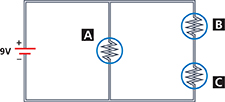CHAPTER 20 Assessment
Reviewing Content
Choose the letter that best answers the question or completes the statement.
A material has a net electric charge because it
discharges.
has an alternating current.
has an excess or shortage of electrons.
has a direct current.
Static electricity is the study of
buildup of charge.
electric discharges.
electric fields.
all of the above.
A strong electric field is
directed toward a charge.
directed away from a charge.
caused by a large quantity of charge.
caused by a small quantity of charge.
What is a material called that easily carries a current?
insulator
semiconductor
electric potential
conductor
A superconducting material
requires very high current.
has no resistance at room temperature.
has no resistance at low temperatures.
has high resistance at low temperatures.
What does Ohm's law state?
Current equals voltage times resistance.
Voltage equals resistance divided by current.
Voltage equals current divided by resistance.
Voltage equals current times resistance.
Which melts to protect a circuit?
three-prong plug
wiring
diode
fuse
What does “ I “ represent in the equation
voltage
resistance
current
kilowatts
The output of a diode can be
direct current.
a superconductor.
resistance.
alternating current.
Three layers of semiconductor material can form
a transistor only.
a diode only.
either a transistor or a diode.
neither a transistor nor a diode.
Understanding Concepts
How does the electric force between two charged objects change if you double the distance between the objects?
What determines the direction of the electric field near a charge?
How can a charged object cause charges to move within an uncharged object?
If the current in a circuit is clockwise, what is the direction of electron flow?
Explain why a wire becomes warmer when charges flow through it.
Does voltage flow in a circuit? Explain.
Use the following diagram to answer Questions 17 and 18. The three bulbs are identical.

Does the same current pass through each bulb? Explain why or why not.
What happens to the other bulbs if bulb A burns out? If bulb B burns out?
A battery and a light bulb are connected in a simple circuit. What is the source of electrons that flow through the wire?
Explain why a light bulb does not change its brightness when another bulb is added in parallel.
What are digital and analog signals?





 Interactive Textbook with assessment at
Interactive Textbook with assessment at